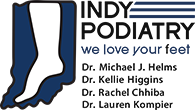 Have you found yourself wanting custom orthotics, but your'e not quite ready to commit? Although the upfront cost may sound a little expensive, the benefits they provide are completely worth it. Here’s a list of reasons why custom orthotics might be right for you:
Have you found yourself wanting custom orthotics, but your'e not quite ready to commit? Although the upfront cost may sound a little expensive, the benefits they provide are completely worth it. Here’s a list of reasons why custom orthotics might be right for you:
1. You suffer from leg, hip, or back pain. Pain in these areas can come from poor foot structure or alignment. With custom orthotics, you will notice that these areas hurt less because orthotics help correct the position and movement of your foot and ankle, thus improving your overall mobility.
2. They are made specifically for your feet. At Indy Podiatry, one of our knowledgeable doctors will custom prescribe and mold your orthotics to fit and support your feet/ankles exactly. Over-the-counter options are nothing more than arch supports, and they lack prescription correction.
3. You are a runner, an exercise walker, or an athlete. If you are active, you’re more prone to developing problems from abnormal foot mechanics. Orthotic devices are often essential to allow successful exercise and sports activities.
4. You stand for long periods of time. If your job requires you to stand for hours on end, custom orthotics can help provide support to your joints and overall relief.
5. You have diabetes. One of the potential problems associated with diabetes is the loss of the ability to feel things in the feet. This is called diabetic neuropathy. Numbness in your feet leads to an increased risk of injury. Custom orthotics can help keep pressure off diabetic ulcers and provide correct foot alignment which then helps to reduce corns, calluses, and chaffing associated with diabetes.
If you have problems with any of the above, one of our doctors can do a complete evaluation to determine where and how your structure and motion deviate from normal. Indy Podiatry is a well-known expert in the area of custom orthotic devices. Taking care of your foot and ankle pain today will help save you time and money in the future. Give us a call today at 317-573-4250.
